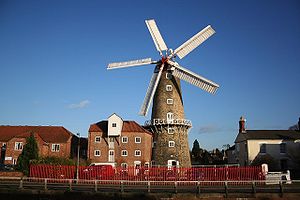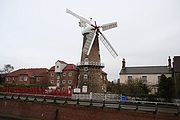
Maud Foster Windmill
Encyclopedia

Windmill sail
Windmills are powered by their sails. Sails are found in different designs, from primitive common sails to the advanced patent sails.-Jib sails:...
windmill
Windmill
A windmill is a machine which converts the energy of wind into rotational energy by means of vanes called sails or blades. Originally windmills were developed for milling grain for food production. In the course of history the windmill was adapted to many other industrial uses. An important...
located by the Maud Foster Drain in Skirbeck
Skirbeck
Skirbeck is a suburb and former civil parish in the Borough of Boston in the county of Lincolnshire, England. Skirbeck is a long v-shaped formation wrapped around the south and east side of Boston parish. It has been incorporated into the Borough of Boston since 1932...
, Boston, Lincolnshire
Lincolnshire
Lincolnshire is a county in the east of England. It borders Norfolk to the south east, Cambridgeshire to the south, Rutland to the south west, Leicestershire and Nottinghamshire to the west, South Yorkshire to the north west, and the East Riding of Yorkshire to the north. It also borders...
, which she takes her name from. She is one of the largest operating windmill
Windmill
A windmill is a machine which converts the energy of wind into rotational energy by means of vanes called sails or blades. Originally windmills were developed for milling grain for food production. In the course of history the windmill was adapted to many other industrial uses. An important...
s in England being 80 feet (24.38 m) tall to the cap ball.
Construction
One of the best sited and proportioned mills in LincolnshireLincolnshire
Lincolnshire is a county in the east of England. It borders Norfolk to the south east, Cambridgeshire to the south, Rutland to the south west, Leicestershire and Nottinghamshire to the west, South Yorkshire to the north west, and the East Riding of Yorkshire to the north. It also borders...
, this beautiful tower mill was erected for Thomas and Isaac Reckitt in 1819 by the Hull
Kingston upon Hull
Kingston upon Hull , usually referred to as Hull, is a city and unitary authority area in the ceremonial county of the East Riding of Yorkshire, England. It stands on the River Hull at its junction with the Humber estuary, 25 miles inland from the North Sea. Hull has a resident population of...
millwrights Norman and Smithson to grind corn that was brought in by barge
Barge
A barge is a flat-bottomed boat, built mainly for river and canal transport of heavy goods. Some barges are not self-propelled and need to be towed by tugboats or pushed by towboats...
along the drain. The original drawings and accounts survive, telling us that it cost £1826-10s-6d, which was a large sum in those days. It shows just how far advanced millwrighting was in this area by 1819, with all-iron gearing, patent sails and a tall, well-proportioned, and untarred tower showing the fine masonry. In her heyday in the mid-19th-century five- and sixed-sailed windmills were not that rare and unusual as they are today.
History

There are five instead of the more usual four patent sails, the shutters of which are now at Wrawby post mill
Post mill
The post mill is the earliest type of European windmill. The defining feature is that the whole body of the mill that houses the machinery is mounted on a single vertical post, around which it can be turned to bring the sails into the wind. The earliest post mills in England are thought to have...
. An unusual feature is the weather beam (or 'rode balk') which is of cast iron, probably replacement of the original wooden one. The brake wheel is of wooden clasp-arm type with an iron tooth ring and wooden brake. The wallower is also of iron with a wooden friction drive to the sackhoist. The dust floor is more spacious than is often found in Lincolnshire and is lit by windows, a welcome change from the gloomy, cramped space usually encountered by mill explorers!
Three pairs of stones, two grey and one French, survive on the fourth floor with vats, spouts etc. all intact. The great spur wheel is of iron, as is the upright shaft. The stone nuts have wooden cogs, as usual. The spout floor gives access to the reefing stage and contains a fine governor which controls all three pairs of stones. The bridge trees are of iron and are Y-shaped, with integral bridging boxes.
In 1987 the mill was bought by James Waterfield and his family who restored her in 1988 to fully working order being now the most productive windmill in all England. Visitors may climb all seven floors and see the milling process in action as well as enjoy fine views of the town from the balcony. Maud's tearoom in the old granary serves morning coffee, lunches and afternoon teas with good old-fashioned home baking and local specialities on the menu. The mill shop sells flour, porridge and good quality souvenirs as well as local history books.
On 11 November 2008, a sail was blown off the mill in a gale. The falling sail landed on one of the mill buildings.

